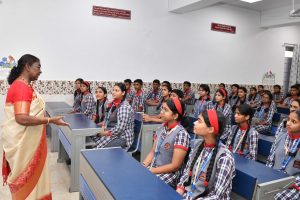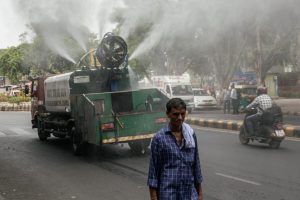India to miss SDG target to reduce stunting among children by 2030: Report

Photo credit Twitter UNICEF India
By Our Special Correspondent
New Delhi, December 20: A PM Economic Advisory Council (PM-EAC) released report has said that India would miss the sustainable development goal (SDG) target in reducing stunting among children by 2030 to six per cent. The report has taken a grim view of the prevalence of anemia among the children and women along with the incidents of stunting.
The Social Progress Index report released on Tuesday has revealed that the government’s bid to improve the nutrition level in the country of the vulnerable sections of the society is not yet yielding the desired results. “Seventeen districts have more than 50 per cent of stunted children, out of which six belong to Uttar Pradesh. Further, 12 districts have more than 50 per cent of underweight children, out of which five belong to Gujarat,” said the report, which has been released with a foreword of the PM-EAC chairman Bibek Debroy.
In the case of stunting, the report noted that no district in India is close to achieving SDG 2030 target for reducing stunted children to six per cent. “On average, 12.32 per cent of children aged 6-23 months can receive an adequate diet. Pathanamthitta district of Kerala has performed significantly better than the rest of Kerala, with 50.1 per cent of children receiving an adequate diet and nutrition. Over 690 districts have less than 30 per cent of children received an adequate diet,” stated the report.
The report also stated that West Singhbhum and Pakur districts of Jharkhand and Dahod district of Gujarat are the only districts with more than 50 per cent of both stunted and underweight children (under five years of age). The report also portrayed Bihar grimly on the social indicators. “The districts of Bihar have some of the lowest NBMC scores, ranging from 18.57 to 38.06, implying that Bihar’s districts are performing poorly across the spectrum of nutrition and basic medical care,” added the report.
Leh and kargil in Ladakh, Kishtwar (Jammu and Kashmir), Lahaul and Spiti (Himachal Pradesh), South Dinajpur and West Medinipur in West Bengal and Udalguri (Assam) are the only districts in India where more than 80 per cent of women are anemic, added the report. On the other hand, Kohima (Nagaland), Ukhrul and Thoubal districts of Manipur, Kra Daadi and Siang districts of Arunachal Pradesh have less than 25 per cent of anemic women.
“At the same time, Leh (Ladakh), Narmada and Panchmahal districts of Gujarat, Lahaul and Spiti (Himachal Pradesh) and Sukma (Chhatisgarh) are the only districts in India where more than 90 per cent of 5-59 months aged children with anemia. Siang (Arunachal Pradesh) and East Garo Hills (Meghalaya) are the only districts with less than 30 per cent anemia among children,” stated the report.
Northeastern districts like South Sikkim (Sikkim), Lower Subansiri (Arunachal Pradesh), Siang (Arunachal Pradesh), Lower Dibang Valley (Arunachal Pradesh), Tawang (Arunachal Pradesh), Aizawl (Mizoram), Jhajjar (Haryana), and Churachandpur (Manipur) have less than 10 per cent of underweight children. These districts are still closer to the SDG 2030 target of reducing underweight children to 1.9 per cent.
“Over 340 districts have scored above the national average of 38.59 for Nutrition and Basic Medical Care component. Pathanamthitta (63.09), Kozhikode (62.21), Thiruvanthapuram (62.03) from Kerala and Longding (62.92) from Arunachal Pradesh are the highest-scoring districts in this subpillar. In contrast, Banka and Lakhisarai from Bihar scored the lowest, i.e. 18.57 and 18.58. There is a significant difference of 44.52 points between India’s highest and lowest-scoring districts,” noted the report.







